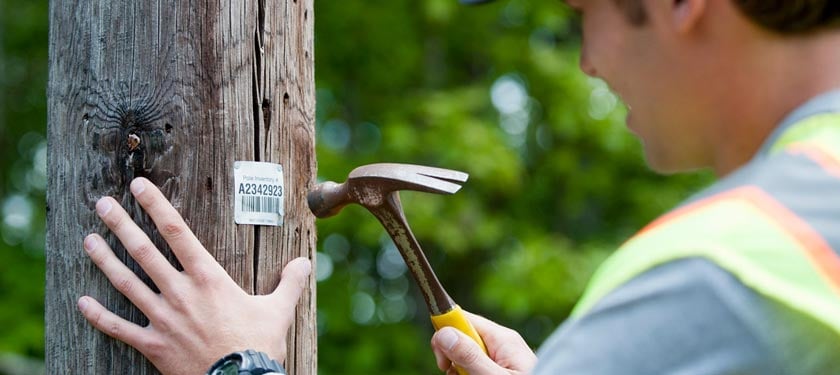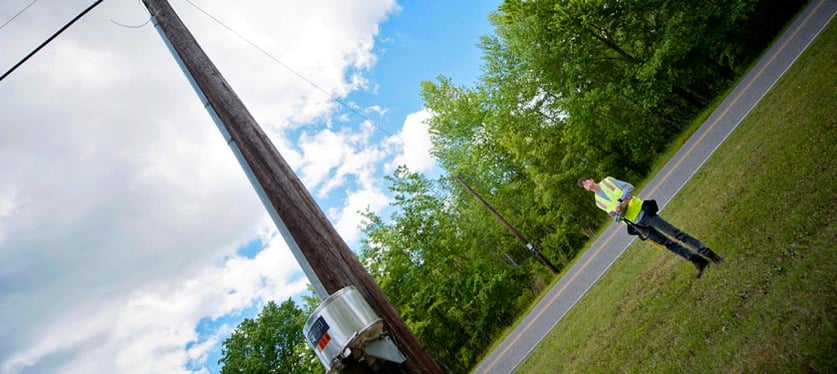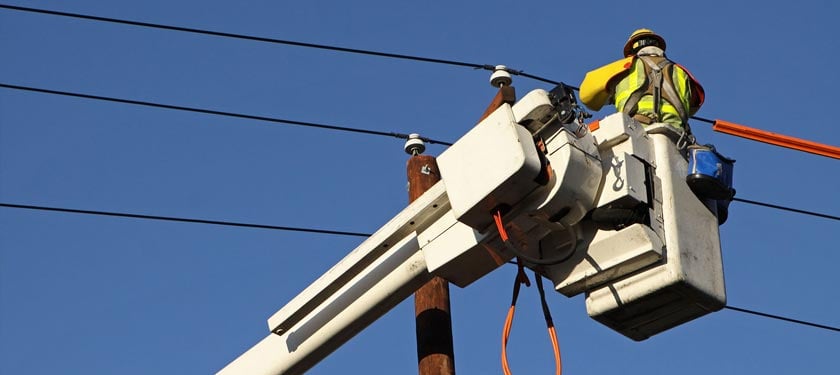

Utility Joint Use Asset Management for the 21st Century
Table of Contents
Introduction
The electric utility industry has been undergoing a significant transition in the past few decades. From the long-gone era of handshake contracts and paper-based (or spreadsheet) asset management processes to the current push from emerging technology companies for greater speed to market and fewer barriers to entry, there is much changing across the spectrum of joint use and real estate asset management.
Utility asset owners are struggling to keep up with billing, maintenance, and work requests. At the same time, new standards are emerging. As software technologies enable data-driven management for electric utilities and communications companies, this evolution paves the way for a future in which jointly used assets are seen as much more valuable real estate.
The following guide reviews the evolution of joint use asset management to establish context and address industry precedents. It discusses the current state of utility asset management, including the push for “one touch make ready” work. And finally, it explores the exciting growth and change that we see coming over the next several decades.
Chapter 1 – The Evolution of Joint Use: The Last 100 Years
The oldest "joint use contract" that Alden has processed was from 1908. At the time, that 108-year-old contract was still in use. The world of utility infrastructure was entirely different at that point in history. To understand what's happening today, and to predict what it will look like in the future, it is important to first understand how it began and evolved.

The Early 20th Century: The Handshake Era
In the beginning, utility poles were owned either by the power company or the telephone company in a mostly even split. Both entities shared space on the poles and operated typically under a parity arrangement. A handshake was sufficient for most joint use agreements, but in some situations, a contract was drawn up. At that time, these contracts were four or five pages at most, compared to the much-longer contracts of today. In 1934, the Communications Act was signed into law. The Act created the Federal Communications Commission (FCC) and established laws to regulate wire and radio communications.
1970s Cable TV is Deployed
The FCC passed rules that required the power and telephone companies to share utility pole infrastructure with CATV providers. The goal was to promote the widespread deployment of cable. The FCC also mandated rental rates for pole attachments. As cable television became increasingly popular, the number of service providers multiplied, as did the number of attachments on utility poles.
1980s The Bell System Was Divested
In 1982, the Bell System was divided up. Competitive local exchange carriers (CLECs) flooded the marketplace, establishing service alternatives and driving down consumer rates.
At the same time, larger incumbent local exchange carriers (ILECs) followed the power companies’ lead and began issuing joint use agreements with companies attaching to their utility poles and other assets. The lines between longstanding parity agreements and newer joint asset agreements quickly became blurred as the marketplace continued to shift.
1990s Deregulation of the Telecommunications Industry
Following the divestiture of the Bell System, the influx of providers led to a large number of mergers and acquisitions. Contracts were frequently transferred to new ownership, affecting both the pole owner and the attachers. As a result, multiple contracts were in place – often for the same company but with different terms – and it became difficult for companies to track and manage those contracts.
The Telecommunications Act of 1996 deregulated the telecom and broadcast industries. As a result, communications companies became subject to greater free market pressure than in the past, which led them to operate as true for-profit businesses. The cost-plus business model was gone.
Electric utilities and communications providers started to look at the real cost of placing, owning and maintaining utility poles in the field. They started breaking away from the parity agreements of the past and started to inventory which poles they owned and where they were located.
As the marketplace – and the nation’s population - continued to grow, these field assets represented opportunities for new infrastructure and build-outs to expand to new locations. Liability also became a concern with an influx of industry lawsuits.
Consumer demand for access to high-speed internet grew rapidly, followed by wireless. Fiber optic networks were installed to support broadband, and DAS antennas were installed to deliver wireless.
The Role of the National Electric Safety Code
The National Electrical Safety Code [NESC] dictates safety standards for power and communication utility supply systems. Its first publication was issued in 1914 and has been updated at various times during the past century. Before the NESC was established, power and telephone infrastructure were constructed without any regulations for material strengths, construction methods, clearance standards or operations.
The Code has undergone several extensive revisions over the years to reflect advances in materials, designs, uses, and construction and operation techniques. Examples of these changes include:
Raising Clearances:
A revision in 1971 adjusted the Code to recognize that “workers were significantly taller than when the Code started. This resulted in raising clearances for the lower voltage conductors and parts in substations, transmission switching stations, and power plants.” The start of the guard zone around energized parts was increased from 7.5 feet to 8.5 feet, which remains in the Code today.
Unobstructed Climbing Space:
The Code requires that climbing space around poles must be an unobstructed. The original Code was fairly broad in its interpretation of obstructions around the pole, such as signage attached to the pole, overgrown vegetation or improperly spaced attachments. However, a 2012 Code change (Rule 217A) specified the definition, saying, “attachments shall not obstruct the climbing space or cause a climbing hazard.”
Wire Gauge Change Due to Fire Hazard:
In response to smaller gauge wire acting like a fuse during surge events and catching some vinyl siding on fire, the conductor size for connection of communication to the supply ground electrode was changed from American wire gauge (AWG) No. 14 to AWG No. 6 copper in the 2012 Code.
Fire Hydrant Clearance:
Clearances between poles and fire hydrants were increased from 3 ft. to 4 ft. in the 2002 edition to recognize the frequent use of gate valve attachments to allow a second fire truck to attach while the first is throwing water.
Chapter 2 – Today: The Modern State of Utility Joint Use Asset & Real Estate Management
A massive influx of attachers combined with increasingly complex regulations, combined with a legally charged environment, has created an intricate, high-pressure situation for asset owners (and asset attachers) in today’s market. While larger companies have created entire departments to take on joint use and real estate asset management, smaller organizations were left with fewer, if any, dedicated resources. Often, this work will fall to one or two people, who may have another "main role."
Without a way to comprehensively manage joint use assets as you can with the Alden One SaaS platform, field assets may go without needed maintenance, pole transfer or permit to attach requests may pile up, and old joint use contracts will only become more outdated, multiplying the risks for asset owners and attachers who are struggling to manage their field equipment. When something catastrophic occurs, the pole owners and attaching companies may face heavy legal ramifications, fines, penalties, and negative publicity.
In response, some asset owners have begun addressing the weaknesses in their joint use asset management approach. Here we profile three leaders in the modernization of utility joint use and real estate management and the strategies they are using to establish efficiency, minimize risk and grow revenues for their businesses.

Two Case Studies for Successful Joint Use Management
The best examples of joint use asset management feature companies that are taking control of data, increasing efficiency and evolving from outdated methods.
Minnesota Power (ALLETTE)– Duluth, Minnesota:
Like many power companies in the U.S., Minnesota Power had traditionally relied on a combination of databases and paper to track utility pole attachments and communicate with partners. They struggled with tracking which poles customers were paying for. To eliminate the piles of paper and email threads, Minnesota Power adopted Alden One, a joint use communication software platform that centralizes all communications and provides digital tracking and invoicing.
With all of the data now easily at their fingertips, asset owners, attachers, and their engineering and construction partners know at every moment exactly how many attachments they have in or on each asset, who is paying for them, and where they are located.
CPS Energy – San Antonio, Texas:
Starting in August 2016, CPS Energy issued a Pole Attachment Standards document that outlines the company’s “One Touch Make Ready” option. This as well as a list of pre-approved contractors to engage for the work. Minimal requirements state that the attacher must notify the owner 72 hours in advance of a transfer and notify the facility owner once the transfer is complete.
Chapter 3 – Looking Ahead: The Future of Utility Joint Use Asset & Real Estate Management
The future of joint use asset management will be a continuing evolution of technology and infrastructure. The industry is crowded with more players now than at any other time in history: power, communications, cable, wireless and fiber. Companies come and go frequently, and new technologies enter the market constantly.

The Internet of Things (IoT)
As the concept of the Internet of Things comes to fruition (the idea that every device will be connected to the internet and to each other), the infrastructure needs for data delivery will expand significantly. Poles and conduit are natural places for that infrastructure.
Smart Joint Use Equipment
Equipment will become more capable of remote data capture and “talking back” to the plant. This kind of machine-to-machine communication will send automatic alerts when equipment is in need of maintenance, and field work can become much more efficient when equipment is capable of self-diagnosis.
Aesthetic Improvements
Especially in newer cities, there is an increasing push to improve unattractive infrastructure. As the number of utility attachers continues to increase, public utility commissions will place greater priority on maintaining an aesthetically pleasing plant.
Excess coils, cable, or wires that have been cut dead can be removed, and double poles can be eliminated. While some plant can be buried, the cost is prohibitive or simply impractical in many areas. Utility poles will continue to be around for a long time, but there will be demands to provide improvements to their appearance.
Joint Use as a Revenue Generating Business
With Alden One's technology offering easier means to manage joint use assets, providers will see the potential for joint use to operate as a self-funded operation and to bring in positive cash flow. Tools like Alden One enable asset owners, attachers, and their partners to efficiently track all joint use assets and activities, oversee regular maintenance, and maintain network reliability.
The Future of Joint Use Into the Next Century
Asset owners have already begun to take proactive action to centralize the joint use function, recognizing that the effort stretches over many departments, including engineering, compliance, and finance. Successful future asset owners will make it easy for attachers to achieve the speed to market that they need and abide by the necessary make ready requirements and safety regulations.
Chapter 4 – A Solution to Enable the Future of Utility Joint Asset Management
Utility asset owners need help managing, maintaining and maximizing the revenue potential of their assets. Alden One provides a streamlined system of processes and software that makes it easy for asset owners to track their field assets, coordinate maintenance activity and make ready work, and communicate with all involved parties in one system.

- Attachment permitting
- Pole construction work management
- Pole replacements
- Corrections
- Make-ready work
- Transfers
- Detach notices
- Pole removals
- Pole installation
Learn how Alden One can help streamline your joint use management. Request a complimentary 1:1 Consultation to learn how Alden One can save time for your business.